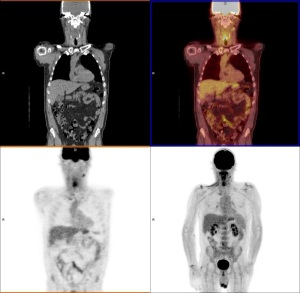por
Lauren Dubinsky, Senior Reporter | March 27, 2016

Courtesy of the
University of Birmingham
Head and neck cancer patients usually have to undergo time-consuming and risky neck dissection surgery after chemoradiotherapy because there is no reliable way to determine which patients still have remaining cancer cells — but new techniques using PET/CT may be changing that.
Researchers at the Universities of Birmingham and Warwick and University Hospitals Coventry and Warwickshire evaluated the use of PET/CT to spot cancer cells that linger after primary chemoradiotherapy and published their results in the
New England Journal of Medicine.
The study spanned 37 centers in the UK from 2007 to 2012 and included 564 patients – 282 who underwent image-guided surveillance and 282 who underwent neck dissection. They found that only 19 percent of those in the image-guided surveillance group went on to undergo neck dissection, compared with 78 percent of those in the other group.



Ad Statistics
Times Displayed: 3993
Times Visited: 28 Most Advanced Boutique Radiology Clinic in Manhattan. Entire facility for sale. Turnkey Operation. Includes prime building lease (7,500 SF) & all equipment: MRI; CT Scanner; PET/CT Scanner & Ultrasound. For more information, See: AuctionAdvisors.com
The researchers also found that survival rates, quality of life and other factors remained consistent among both of the groups.
Even though patient outcomes and avoiding unnecessary surgery are the main goals of the study, there was also a cost-saving component. PET/CT-guided surveillance saved the National Health Service in England $2,190 per patient compared with neck dissection, according to the researchers.
“Carry that across the tens of thousands of cases each year across the world and you see a significant saving that can be redistributed into other therapies,” Hisham Mehanna, professor at the University of Birmingham, said in a statement.
The annual incidence of head and neck cancers worldwide is more than 550,000 cases with about 300,000 deaths each year, according to the World Health Organization. About 90 percent of all head and neck cancers are squamous cell carcinomas, which is the sixth leading cancer by incidence across the globe.
The study was funded by the National Institute for Health Research (NIHR) Health Technology Assessment (HTA) Programme. The office for life sciences, which is part of the Department for Business, Innovation and Skills and the Department of Health, has invested £1 billion every year in the NIHR during this Parliament.

